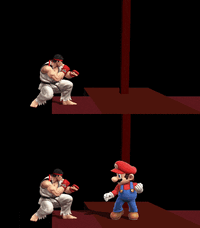Special canceling
Special canceling (officially called attack canceling, referred to in combo notation as xx) is a gameplay mechanic in Super Smash Bros. 4 and Super Smash Bros. Ultimate. It lets the playstyle of Ryu, Ken, and Terry be closer to that of their respective home series.
While many moves have interruptibility to allow the user to perform an action before that move's animation completes, special canceling allows the user to perform a special move or a command-input move much earlier. It is performed by hitting a character with a move that can be special move canceled and then performing a special move or a command-input move after hitlag ends, therefore negating the ending lag of the move that was canceled. Neutral attacks, tilts, and aerials are the only attacks that can be special move canceled, with the exception of Ryu and Ken's down smash.
Because most of the moves that can be canceled have relatively low knockback, they are very useful in extending combos, setting up for KOs, or applying shield pressure. Ryu's heavy down tilt, for example, can normally be interrupted starting at frame 28, but canceling into a special move allows him to act as early as frame 6. The window to perform another move does not extend to the end of the initial move's animation, with most being a 10 frame or fewer window starting from when the first hitbox is active. An extreme example of this is Ryu's neutral aerial, which has a hitbox as late as frame 31 but the special move cancel window ends at frame 13.
A related mechanic exists for Final Smashes with only two main differences. The first difference is that almost every move aside from pummel, throws, floor attacks, and edge attacks can be canceled into a Final Smash. The second difference is the window is often much smaller than for specials, often closing as soon as the last hitbox ends, though several do have the same timing as the special move cancel window.
Kara canceling is a similar mechanic that applies to the same moves as special move canceling. Unlike special move canceling, Kara canceling can only within 4 frames of performing the move and before any hitbox connects.
List of moves[edit]
Note: All windows are based on the frame of the respective move that is being replaced by the first frame of a special move
SSB4[edit]
| Fighter | Move | Window | FS window |
|---|---|---|---|
| Neutral attack 1 (tapped) | |||
| Up tilt (tapped) | |||
| Up tilt (held) | |||
| Down tilt (tapped) | |||
| Down tilt (held) |
Ultimate[edit]
| Fighter | Move | Window | FS window |
|---|---|---|---|
| Neutral attack 1 (tapped) | 3-11 | ||
| Neutral attack 2 (tapped) | 4-12 | ||
| Neutral attack (close, held) | 8-20 | ||
| Forward tilt (close, tapped) | 4-24 | ||
| Up tilt (tapped) | 4-7 | ||
| Up tilt (held) | 8-20 | ||
| Down tilt (tapped) | 3-9 | ||
| Down tilt (held) | 7-19 | ||
| Down smash | 6-13 | ||
| Neutral aerial | 5-13 | ||
| Forward aerial | 9-14 | ||
| Up aerial | 7-15 | ||
| Back aerial | 9-17 | ||
| Down aerial | 9-17 | ||
| Neutral attack 1 (tapped) | 3-11 | ||
| Neutral attack 2 (tapped) | 4-12 | ||
| Neutral attack (close, held) | 8-20 | ||
| Forward tilt (close, tapped) | 8-24 | ||
| Up tilt (tapped) | 4-7 | ||
| Up tilt (held) | 8-20 | ||
| Down tilt (tapped) | 3-9 | ||
| Down tilt (held) | 7-19 | ||
| Down smash | 6-13 | ||
| Neutral aerial | 5-13 | ||
| Forward aerial | 9-14 | ||
| Up aerial | 6-16 | ||
| Back aerial | 9-17 | ||
| Down aerial | 9-17 | ||
| Neutral attack 1 | 4-8 | ||
| Neutral attack 2 | 6-19 | ||
| Forward tilt | 9-19 | ||
| Up tilt | 8-19 | ||
| Down tilt | 7-15 | ||
| Neutral aerial | 5-23 | ||
| Up aerial | 8-17 | ||
| Down aerial | 13-19 |
Origin[edit]
Special canceling can be traced back to the 1991 arcade fighting game Street Fighter II: The World Warrior. After receiving complaints that the input window for all attacks, but especially special moves in the first Street Fighter game was too strict, Capcom decided to make the input window much more lenient at the expense of a roster-wide nerf to damage. This made inputs much easier to perform, but caused an unintended side effect where players could cancel moves into each other before the opponent could exit hitstun. This is due to the input window overlapping with the attack animation and the game prioritizing the next attack over cooldown. This oversight is often recognized as creating the first instance of modern combos in fighting games, as previously stated, this was not an intentional decision.
The glitch was well received by fans and became an integral part of competitive play. The fast-paced, technical, combo-centric gameplay is what set the Street Fighter II apart in arcades, which encouraged other companies to intentionally include the mechanic. Later Street Fighter games introduced a combo counter that will tally how long a combo lasts to add to a player's high score, which other games also adopted. Some games like Killer Instinct even made a gimmick out of combos, encouraging players to make as long a combo as possible, up into the hundreds.

